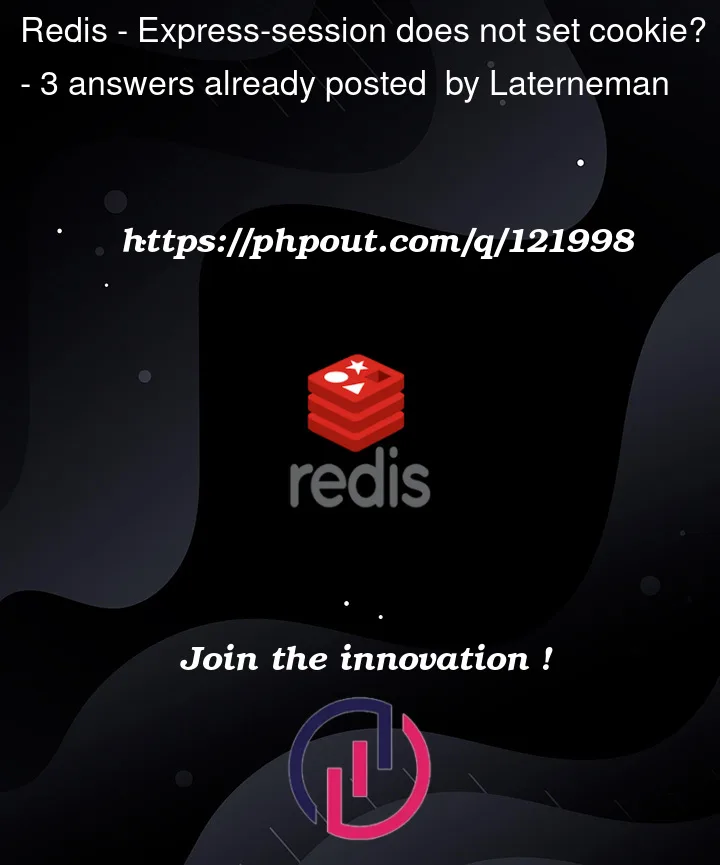I’m following along with Ben Awad’s 13-hour Fullstack React GraphQL TypeScript Tutorial and encountered a wall during the login cookie setting (aprx at 1:50:00).
I think I successfully connected to redis, set express-session and set req type but in graphql sandbox I don’t see my cookie (named ‘qid’) at Inspect->Application.
index.ts
import { MikroORM } from "@mikro-orm/core";
import { __prod__ } from "./constants";
import microConfig from "./mikro-orm.config";
import express from "express";
import { ApolloServer } from "apollo-server-express";
import { buildSchema } from "type-graphql";
import { HelloResolver } from "./resolvers/hello";
import { PostResolver } from "./resolvers/post";
import { UserResolver } from "./resolvers/user";
import redis from "redis";
import session from "express-session";
import connectRedis from "connect-redis";
const main = async () => {
const orm = await MikroORM.init(microConfig);
await orm.getMigrator().up();
const app = express();
const RedisStore = connectRedis(session);
const redisClient = redis.createClient();
app.use(
session({
name: "qid",
store: new RedisStore({
client: redisClient,
disableTouch: true,
}),
cookie: {
maxAge: 1000 * 60 * 60 * 24 * 365 * 10,
httpOnly: true,
sameSite: "none",
// secure: __prod__,
},
saveUninitialized: false,
secret: "dfhfdjkgfkbjktzkzf",
resave: false,
})
);
app.use(function (req, res, next) {
res.header(
"Access-Control-Allow-Origin",
"https://studio.apollographql.com"
);
res.header("Access-Control-Allow-Credentials", "true");
next();
});
const apolloServer = new ApolloServer({
schema: await buildSchema({
resolvers: [HelloResolver, PostResolver, UserResolver],
validate: false,
}),
context: ({ req, res }) => ({ em: orm.em, req, res }),
});
await apolloServer.start();
apolloServer.applyMiddleware({
app,
cors: {
credentials: true,
origin: new RegExp("/*/"),
},
});
app.listen(4000, () => {
console.log("server started on port 4000");
});
};
main();
types.ts
import { EntityManager, IDatabaseDriver, Connection } from "@mikro-orm/core";
import { Request, Response } from "express";
import { Session, SessionData } from "express-session";
export type MyContext = {
em: EntityManager<any> & EntityManager<IDatabaseDriver<Connection>>;
req: Request & {
session: Session & Partial<SessionData> & { userId: number };
};
res: Response;
};
and my userResolver (user.ts)
import { User } from "../entities/User";
import { MyContext } from "../types";
import {
Arg,
Ctx,
Field,
InputType,
Mutation,
ObjectType,
Query,
Resolver,
} from "type-graphql";
import argon2 from "argon2";
@InputType()
class UsernamePasswordInput {
@Field()
username: string;
@Field()
password: string;
}
@ObjectType()
class FieldError {
@Field()
field: string;
@Field()
message: string;
}
@ObjectType()
class UserResponse {
@Field(() => [FieldError], { nullable: true })
errors?: FieldError[];
@Field(() => User, { nullable: true })
user?: User;
}
@Resolver()
export class UserResolver {
@Mutation(() => UserResponse)
async login(
@Arg("options", () => UsernamePasswordInput) options: UsernamePasswordInput,
@Ctx() { em, req }: MyContext
): Promise<UserResponse> {
const user = await em.findOne(User, { username: options.username });
if (!user) {
return {
errors: [
{
field: "username",
message: "username does not exist",
},
],
};
}
const valid = await argon2.verify(user.password, options.password);
if (!valid) {
return {
errors: [
{
field: "password",
message: "incorrect password",
},
],
};
}
req.session.userId = user.id;
return {
user,
};
}
}
I tried setting up res.headers as graphql sandbox is asking but still to no avail. Would appreciate any help, thank you!




3
Answers
Okay I'm not sure what is happening, but I seemingly solved the issue.
My idea is that: GraphQL Playground is retired and localhost:port/graphql now redirects to Apollo GraphQL Sandbox to a different url and my guess is that the cookies do not get transfered to this location but the cookie is set at localhost.
So there is a way you can force Apollo to still use the Playground by adding:
And this way Playground shows up and you can set
in the settings and voila the cookie shows up at localhost:port.
I hope this helps anyone with this issue - however I'm still not exactly sure that this is a right solution.
Adding the old playground as a plugin probably works but, since they say it is being deprecated, if you want to make it work with the new Apollo Studio, here is how I managed to do it:
I added these three lines right after initializing the app:
Here is how the configuration of my session looks like:
Then, over to Apollo Studio, go to Connection Settings -> Edit -> Include Cookies (this one was really hard to find):
Make sure to send this header with every request to login:
x-forwarded-proto: httpsspent some time on this one. Try this combined solution:
Also dont forget to this
setup and hard-reset your https://studio.apollographql.com/sandbox/.
And this: add ENV to your root
Then you should be ready to go.